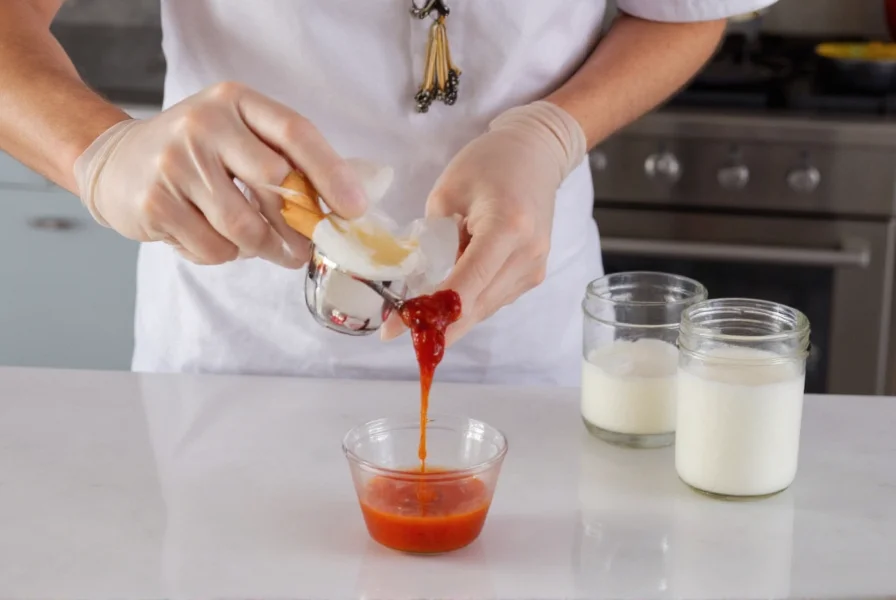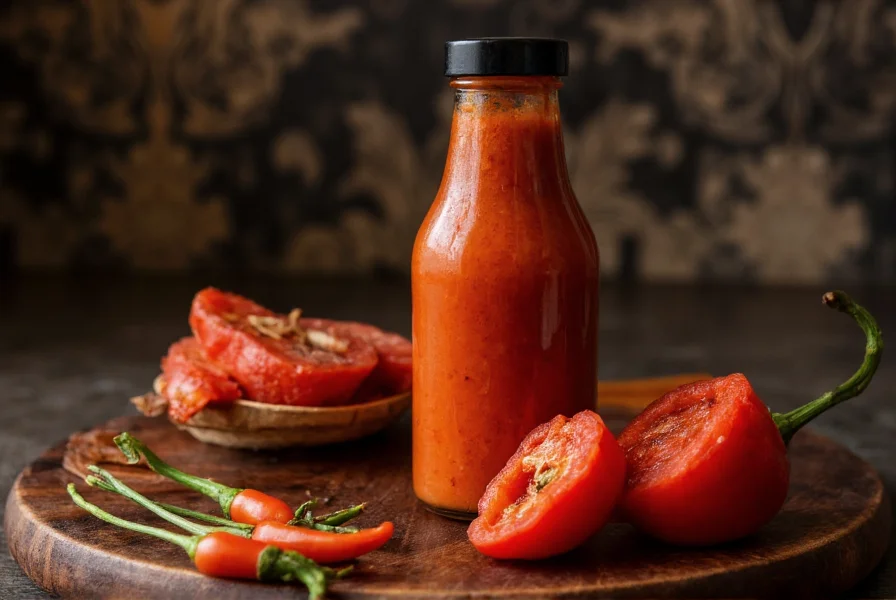Ghost pepper sauce is an extremely hot condiment made from Bhut Jolokia peppers (ghost peppers), typically ranging from 800,000 to 1,041,000 Scoville Heat Units (SHU), making it approximately 200-400 times hotter than Tabasco sauce. This intense heat requires careful handling and measured usage in culinary applications.
Understanding the true nature of ghost pepper sauce begins with recognizing its place among the world's hottest peppers. The ghost pepper, scientifically known as Capsicum chinense 'Bhut Jolokia', earned its name from the Hindi word for ghost (bhut) due to the almost supernatural burning sensation it produces. When transformed into sauce form, this pepper delivers an intense heat experience that demands respect and knowledge for safe enjoyment.
The Science Behind Ghost Pepper Sauce Heat
Ghost pepper sauce's extreme heat comes from capsaicinoids, primarily capsaicin and dihydrocapsaicin. The Scoville scale measures these compounds' concentration:
| Pepper Type | Scoville Heat Units (SHU) | Heat Comparison |
|---|---|---|
| Ghost Pepper Sauce | 800,000-1,041,000 | 200-400x Tabasco |
| Habanero Pepper | 100,000-350,000 | 12-28x Jalapeño |
| Tabasco Sauce | 2,500-5,000 | 1-2x Jalapeño |
| Jalapeño Pepper | 2,500-8,000 | Baseline |
This scientific context explains why how hot is ghost pepper sauce remains one of the most common questions among newcomers to superhot peppers. Unlike milder sauces where heat serves as background flavor, ghost pepper sauce dominates the sensory experience, requiring strategic culinary application.
Safety Considerations for Handling Ghost Pepper Sauce
Working with ghost pepper sauce demands serious precautions. The capsaicin concentration can cause severe skin irritation and respiratory issues. Always follow these safety protocols:
- Wear nitrile gloves (latex won't protect against capsaicin)
- Avoid touching your face, especially eyes and nose
- Work in a well-ventilated area or use a fume hood
- Have dairy products (milk, yogurt) nearby for accidental overexposure
- Never use plastic containers that might absorb capsaicin
If you experience burning skin, wash with soap and cold water (hot water opens pores). For eye exposure, flush with saline solution for 15 minutes. Understanding these ghost pepper sauce safety tips prevents painful accidents that often accompany first-time use.

Culinary Applications: Using Ghost Pepper Sauce Effectively
The key to successful ghost pepper sauce uses lies in restraint and strategic application. Unlike milder hot sauces that can be generously applied, ghost pepper sauce works best when used sparingly as a finishing touch. Consider these proven techniques:
Flavor Pairing Principles
Ghost pepper sauce complements rich, fatty foods that help moderate its heat:
- Creamy bases: Mix with sour cream, yogurt, or mayonnaise for dipping sauces
- Meat dishes: Add to barbecue sauces or rubs for depth (1-2 drops per cup)
- Seafood: Enhances ceviche or shrimp cocktails in minute quantities
- Vegetarian options: Elevates roasted vegetables or bean dishes
When exploring what to eat with ghost pepper sauce, remember that balance is essential. The sauce should enhance, not overwhelm, the dish's primary flavors.
Creating Your Own Ghost Pepper Sauce
For those interested in making ghost pepper sauce at home, fermentation creates complex flavors while maintaining heat. Here's a professional approach:
Basic Fermented Ghost Pepper Sauce Recipe
- 10 fresh ghost peppers (stems removed)
- 4 cloves garlic
- 1½ cups filtered water
- 3 tablespoons non-iodized salt
- 1 tablespoon vinegar (after fermentation)
Process: Combine peppers, garlic, and saltwater brine in a fermentation vessel. Weight to submerge ingredients. Ferment at room temperature for 7-14 days, burping daily. Blend when bubbles slow, strain, and add vinegar. Bottle in sterilized containers.
This method produces a more nuanced ghost pepper sauce recipe than quick vinegar-based versions, with deeper flavor complexity. The fermentation process also slightly reduces perceived heat while maintaining Scoville levels.

Commercial Sauce Selection Guide
When evaluating store-bought options, look for these quality indicators:
- Simple ingredient lists (peppers, vinegar, salt, maybe garlic)
- No artificial colors or preservatives
- Transparent heat labeling (SHU ratings)
- Reputable producers with pepper expertise
Be cautious of sauces claiming "ghost pepper" that list vague ingredients like "natural flavors" or "spice blend." Authentic ghost pepper sauce vs habanero products will clearly state their pepper content and heat level. Remember that shelf life typically ranges from 6-12 months when refrigerated after opening.
Managing the Heat Experience
When consuming ghost pepper sauce, follow these guidelines for optimal enjoyment:
- Start with 1/8 teaspoon or less per serving
- Pair with dairy (milk, cheese, yogurt) to neutralize capsaicin
- Avoid carbonated beverages which can spread the heat
- Have honey or sugar nearby to counteract extreme heat
- Wait 15-20 minutes between increments to assess heat level
Understanding these practical applications transforms the experience from painful ordeal to culinary adventure. The goal isn't just heat tolerance but flavor appreciation—ghost pepper sauce benefits include enhanced flavor complexity when used properly, not just mouth burn.
How much ghost pepper sauce should I use in recipes?
Start with 1/8 teaspoon or less per serving. Ghost pepper sauce is extremely potent—most recipes require only a few drops. Add incrementally, waiting 15-20 minutes between additions to assess heat level before continuing.
What neutralizes ghost pepper sauce burn?
Dairy products like milk, yogurt, or sour cream effectively neutralize capsaicin. Fats and casein in dairy bind to capsaicin molecules. Sugar, honey, or starchy foods can also help absorb the heat. Avoid water, which spreads capsaicin rather than neutralizing it.
How does ghost pepper sauce compare to other superhot sauces?
Ghost pepper sauce (800,000-1,041,000 SHU) is significantly hotter than habanero sauce (100,000-350,000 SHU) but milder than Carolina Reaper sauce (1,400,000-2,200,000 SHU). Ghost pepper offers a distinct fruity flavor beneath the heat, whereas Reaper has more chocolate notes.
Can I substitute ghost pepper sauce for regular hot sauce?
Yes, but with extreme caution. Use only 1/10 to 1/20 the amount of ghost pepper sauce compared to regular hot sauce. For example, where a recipe calls for 1 teaspoon of Tabasco, use just 1-2 drops of ghost pepper sauce. Always adjust gradually to avoid overwhelming heat.
How long does homemade ghost pepper sauce last?
Properly fermented and bottled ghost pepper sauce lasts 6-12 months refrigerated. Vinegar-based versions last 3-6 months. Always check for mold, off smells, or color changes before use. The heat level remains stable over time, though flavor complexity may diminish slightly.











 浙公网安备
33010002000092号
浙公网安备
33010002000092号 浙B2-20120091-4
浙B2-20120091-4